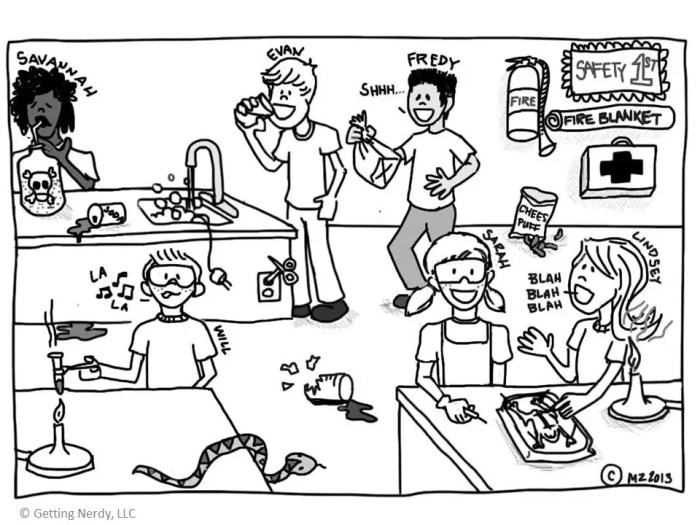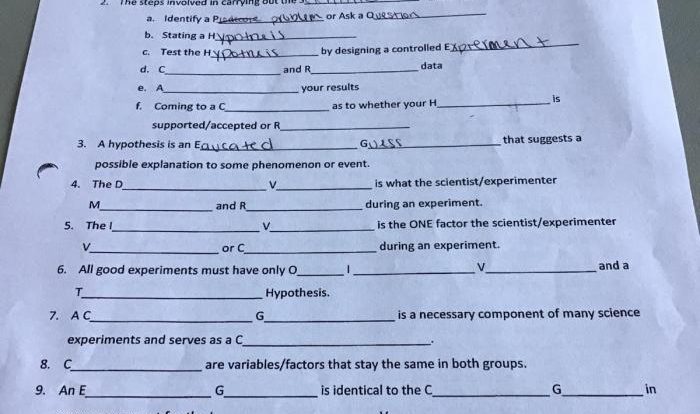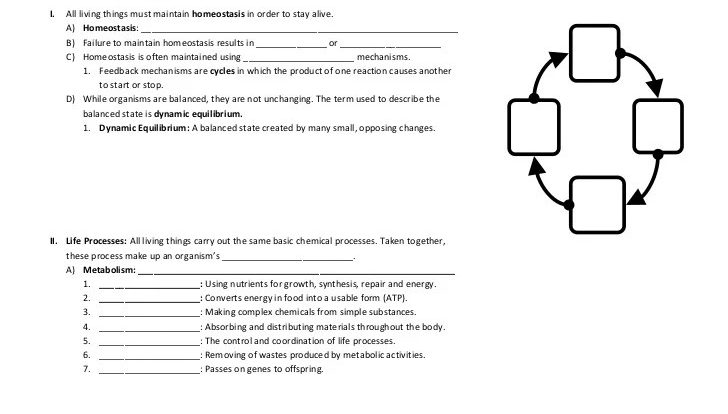Understanding the safety regulations and guidelines in a science laboratory is crucial for maintaining a safe and productive learning environment. This comprehensive guide to safety in the science laboratory worksheet answers provides an overview of essential safety protocols, hazard identification and risk assessment, personal protective equipment (PPE), emergency procedures, waste management and disposal, and laboratory etiquette.
By adhering to these guidelines, students can minimize risks and ensure a safe learning experience.
Safety Regulations and Guidelines
Adhering to safety regulations in the science laboratory is paramount to ensure the well-being of individuals and prevent accidents. These regulations establish clear guidelines for conduct, handling equipment, and disposal of materials to minimize risks and create a safe working environment.
Common Safety Rules and Regulations
- Wear appropriate personal protective equipment (PPE) at all times.
- Never eat or drink in the laboratory.
- Keep work areas clean and organized.
- Never work alone in the laboratory.
- Report any accidents or incidents to the instructor immediately.
Consequences of Violating Safety Protocols
Violating safety protocols can have severe consequences, including:
- Injury to oneself or others
- Damage to equipment or materials
- Fires or explosions
- Chemical spills or contamination
- Disciplinary action or fines
Hazard Identification and Risk Assessment

Identifying and assessing risks associated with laboratory procedures is crucial for preventing accidents. Hazards can be physical, chemical, biological, or ergonomic.
Types of Laboratory Hazards
- Physical hazards: sharp objects, heavy equipment, electrical hazards
- Chemical hazards: toxic substances, corrosive chemicals, flammable liquids
- Biological hazards: bacteria, viruses, fungi
- Ergonomic hazards: repetitive motions, awkward postures
Risk Assessment
Risk assessment involves evaluating the likelihood and severity of potential hazards. This can be done using a risk assessment matrix that considers factors such as:
- Nature of the hazard
- Exposure level
- Protective measures in place
- Consequences of exposure
Personal Protective Equipment (PPE): Safety In The Science Laboratory Worksheet Answers
PPE is essential for protecting individuals from potential hazards in the laboratory. Common types of PPE include:
Types of PPE
- Safety glasses
- Lab coat or apron
- Gloves
- Respirator
- Hearing protection
Proper Use and Maintenance of PPE
Proper use and maintenance of PPE is crucial for its effectiveness. This includes:
- Selecting the appropriate PPE for the task
- Wearing PPE correctly and comfortably
- Inspecting PPE regularly for damage
- Cleaning and disinfecting PPE after use
Emergency Procedures
In the event of a laboratory accident or emergency, it is essential to follow established procedures to minimize harm and ensure safety.
Steps to Follow in Case of an Emergency
- Remain calm and assess the situation.
- Notify the instructor immediately.
- Evacuate the laboratory if necessary.
- Follow instructions from the instructor or emergency responders.
Emergency Equipment and Exits
It is crucial to know the location of safety equipment and emergency exits in the laboratory. This includes:
- Fire extinguishers
- Eye wash stations
- Safety showers
- Emergency exits
Waste Management and Disposal
Proper waste management is essential for protecting the environment and human health. Laboratory waste can be hazardous or non-hazardous, and each type requires specific disposal methods.
Hazardous Waste
Hazardous waste includes chemicals, biological materials, and radioactive substances. It must be disposed of according to local and federal regulations.
Non-Hazardous Waste
Non-hazardous waste includes paper, plastic, and glass. It can be disposed of in regular trash bins.
Waste Disposal Methods
Common waste disposal methods include:
- Incineration
- Landfilling
- Neutralization
- Recycling
Laboratory Etiquette
Maintaining a safe and respectful laboratory environment is essential for the well-being of all individuals. Appropriate behavior includes:
Appropriate Conduct, Safety in the science laboratory worksheet answers
- Respect others and their work
- Be aware of your surroundings
- Clean up your work area after use
- Report any unsafe conditions or practices
Consequences of Disruptive or Unsafe Behavior
Disruptive or unsafe behavior can have consequences, including:
- Verbal warnings
- Removal from the laboratory
- Disciplinary action
Helpful Answers
What are the most common safety regulations in a science laboratory?
Common safety regulations include wearing appropriate attire, following instructions carefully, keeping work areas clean and organized, and reporting any accidents or spills immediately.
How can I identify hazards in a science laboratory?
Look for potential hazards such as chemicals, equipment, and electrical cords. Assess the risks associated with each hazard and take appropriate precautions.
What is the proper way to wear a lab coat?
Wear a lab coat buttoned up and with sleeves rolled down. Make sure the coat is the correct size and does not hinder movement.
What should I do in the event of a chemical spill?
If a chemical spill occurs, notify the instructor immediately. Wear appropriate PPE and follow the emergency procedures Artikeld in the laboratory safety manual.



